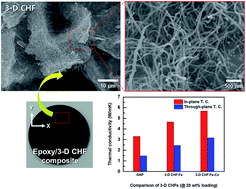Enhanced thermal conductivity of epoxy/three-dimensional carbon hybrid filler composites for effective heat dissipation
Abstract
Graphitic carbon nanomaterials (CNMs) are recognized as next-generation heat dissipating materials (HDMs) for efficient thermal conduction within a polymer composite. Commercially used carbon-based HDMs, including carbon blacks, carbon nanotubes (CNTs), and graphites, are limited by low thermal conductivity under 50% filler content. Two-dimensional graphenes show high thermal conductivity in their major (xy) planes; however, they still exhibit low thermal conductivity in the z direction, i.e., perpendicular to the major plane, because of the difficulty in obtaining a proper vertical alignment. Here, we introduce a straightforward strategy to improve the thermal conductivity of graphene-based HDMs in both the xy- and z-directions and report the results of our investigation of the thermal conductivity behavior of the epoxy composites. Our newly designed graphene-based HDMs were observed to adopt directly anchored and ohmic-contact morphologies between graphene nanoplatelets (GNP) and CNTs via bimetallic nanoparticle decoration on the GNP surface and subsequent carbon vapor deposition (CVD), and their epoxy composites showed an approximately two-fold enhancement of both in- and through-plane thermal conductivities compared to those of bare GNPs.


 Please wait while we load your content...
Please wait while we load your content...